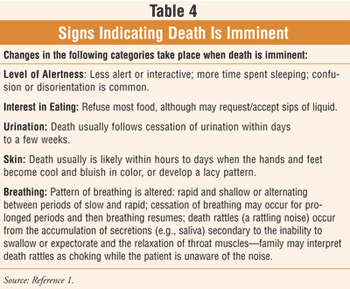The Actively Dying Phase of The Dying Process
Published on August 25, 2023
Updated on April 21, 2024
Published on August 25, 2023
Updated on April 21, 2024

Table of Contents
For a non-healthcare professional who has never witnessed death before, it can be unsettling to be present with someone who is nearing the end of their life. However, there are certain signs and observations that you can make using your senses that may indicate that the person you are with may pass away within seconds, minutes, or hours. Understanding these signs can help you provide support and comfort to the individual and their loved ones during this grim time.
One of the most noticeable signs that someone may be approaching death is a change in their breathing pattern. Pay attention to the following:
As the person nears death, they may become less responsive to their surroundings. Look for these signs:
Observing changes in the person’s skin can provide important clues about their condition:
Monitoring urine output can be an indirect indicator of the body’s declining function:
Although measuring vital signs accurately requires medical equipment, you can still look out for certain observable changes:
While not always present, some individuals may experience restlessness or agitation in their final moments (these signs can occur as close to three days before death or as far as two to four weeks before death):
Remember, these signs are not definitive indicators; each person’s experience can vary. It is essential to consult with healthcare professionals for an accurate assessment and guidance in providing care.
As a supportive presence, you offer comfort, reassurance, and a calming presence to the dying person and their loved ones. Be attentive, hold their hand, speak softly, and provide comfort measures such as adjusting pillows, moistening their lips, or playing soothing music.
The actively dying phase of the dying process can be a challenging and emotional time for both the individual and their loved ones. Understanding the signs and observations that may indicate that a person is nearing the end of their life can help provide support and comfort during this difficult time. Changes in breathing, decreased responsiveness, changes in skin color and temperature, decreased urine output, and changes in vital signs are some of the physical signs that may be observed. Additionally, terminal restlessness or agitation may also be present in some individuals. It’s important to note that these signs are not definitive indicators, and each person’s experience can vary. Therefore, consulting with your hospice provider for an accurate assessment and guidance in providing care is essential. As a supportive presence, offering comfort, reassurance, and a calming presence to the dying person and their loved ones is crucial. Being attentive, holding their hand, speaking softly, and providing comfort measures such as adjusting pillows, moistening their lips, or playing soothing music can help create a peaceful environment during this challenging time. Remember, the dying process is highly variable, and it’s important to approach it with empathy, compassion, and understanding.
Between Life and Death: A Gospel-Centered Guide to End-of-Life Medical Care
Providing Comfort During the Last Days of Life with Barbara Karnes RN (YouTube Video)
Preparing the patient, family, and caregivers for a “Good Death.”
Velocity of Changes in Condition as an Indicator of Approaching Death (often helpful to answer how soon? or when?)
The Dying Process and the End of Life
Gone from My Sight: The Dying Experience
The Eleventh Hour: A Caring Guideline for the Hours to Minutes Before Death
By Your Side, A Guide for Caring for the Dying at Home
Hospice Nurse Julie’s video of an actively dying patient
Actively Dying Learn about Death and Lessen the Fear of Death (Video)
End-of-Life Stages Timeline: What to expect as someone nears death
What Are 5 Physical Signs of Impending Death?
11 End-of-Life Symptoms in Older Adults
Comfort Measures: Practical Care of the Dying Cancer Patient
The Dying Patient: Choices, Control, and Communication
Slide Player Presentation: The Stages of Death. SIGNS AND SYMPTOMS OF APPROACHING DEATH